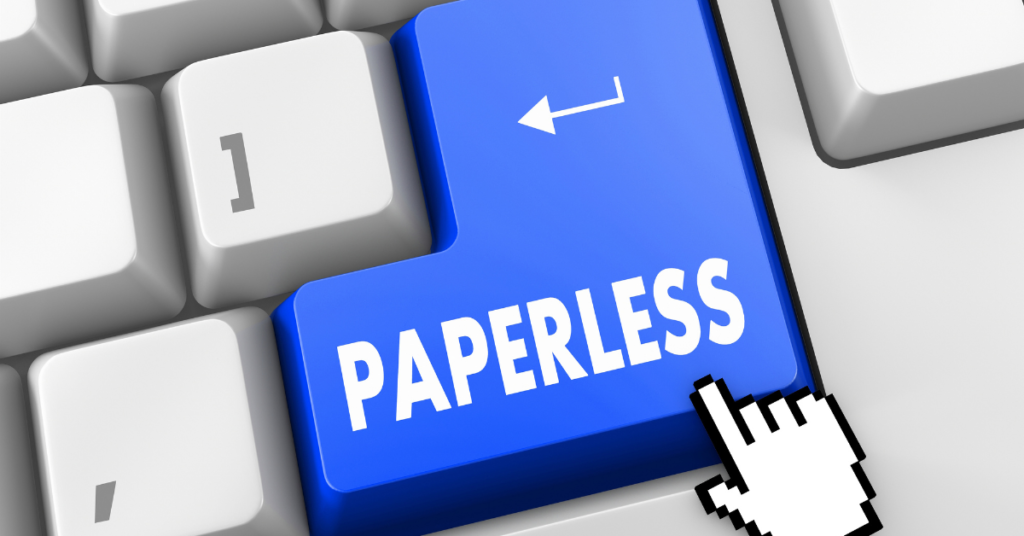In today’s fast-paced and increasingly digital world, Filipino healthcare professionals are under mounting pressure to provide high-quality care while maintaining operational efficiency. Are you still relying on paper-based systems for patient records, scheduling, and other administrative tasks? If so, it could be time to consider the benefits of transitioning to a paperless trail with an Electronic Medical Records (EMR) system.
Adopting a paperless system offers a wide range of benefits. First, it streamlines the management of patient records, allowing healthcare providers to easily access and update information in real-time, ensuring that patient data is accurate and up to date. With a paperless EMR, you can also reduce the time spent on manual tasks like organizing files, which can improve efficiency and reduce administrative overhead.
Moreover, going paperless helps to minimize human error, prevent loss or damage to records, and improve securitythrough secure digital encryption. The move to a paperless system will also enhance your practice’s workflow, enabling faster communication among staff and a more organized approach to patient care. Most importantly, it boosts patient satisfaction by offering quicker appointment scheduling, smoother consultations, and a more streamlined overall experience. So, why wait? Embrace the future of healthcare with a paperless solution today!
Why the Paperless Trail Makes Sense for Filipino Doctors and Clinics
As healthcare continues to evolve, the need for paperless operations has never been more critical. According to a report by the Philippine Department of Health, only 20% of healthcare providers in the country are fully digitized, which highlights the significant potential for greater efficiency and accuracy through technology. With the rapid advancements in digital health solutions, it’s clear that Filipino doctors, clinics, and telemedicine providers can benefit greatly from transitioning to a paperless system.
So, why should Filipino healthcare professionals make the switch to an EMR system? For starters, a paperless trail helps eliminate the risk of lost or damaged patient records, which can be crucial when making important medical decisions. It also reduces administrative burdens, freeing up time for medical staff to focus on patient care rather than paperwork. Additionally, EMR systems enable faster access to patient data, resulting in quicker decision-making and more efficient consultations.
Moreover, with the growing demand for telemedicine and digital health services, adopting a paperless system allows clinics and private practitioners to stay competitive in an increasingly tech-driven healthcare landscape. With improved security features and cost-saving potential, moving to a paperless system isn’t just a trend—it’s a strategic move for the future.
1. Streamlined Patient Records Management
One of the biggest benefits of adopting a paperless system is the ease of managing patient records. Traditional paper-based records can get lost, damaged, or simply take up too much space. With an EMR system, patient information is securely stored, easily accessible, and updated in real-time. Doctors can instantly retrieve a patient’s medical history, previous visits, lab results, and prescriptions with just a few clicks.
Moreover, digital records are less prone to errors. As Dr. Ana Garcia, a veteran family physician, explains: “With paper records, I would sometimes struggle to read illegible handwriting, which could lead to mistakes in patient care. Now, everything is clear and accurate.”
2. Improved Scheduling and Efficiency
Managing appointments manually often leads to mistakes or double-bookings. With a paperless EMR system, scheduling becomes a breeze. Clinics can set up automated reminders for patients and manage bookings online without the usual administrative headaches. This means fewer missed appointments, more accurate scheduling, and a better patient experience.
Telemedicine providers can also take advantage of digital scheduling systems, allowing patients to easily book virtual consultations. It’s as simple as a few clicks—no phone calls or paper logs needed!
3. Better Collaboration Between Healthcare Providers
In the Philippines, healthcare professionals often work across various settings: hospitals, clinics, telemedicine platforms, and even mobile health services. A paperless trail enables seamless communication and collaboration between different practitioners, specialists, and medical centers. When patient information is stored digitally, it can be easily shared across platforms in real-time.
This leads to faster diagnoses and more coordinated care. Dr. Luis Rivera, a surgeon at a private clinic in Manila, shares: “In the past, I would have to call or wait for faxes with patient reports from other hospitals. Now, everything is uploaded to the system in seconds, making it easier for me to make timely decisions.”
4. Increased Security and Compliance
Confidentiality is a top priority in healthcare. Paper records can be easily lost, stolen, or accessed by unauthorized individuals. On the other hand, an EMR system typically includes strong encryption and secure authentication measures to ensure that patient information is protected.
Moreover, many EMR systems are designed to comply with local laws and regulations, ensuring that healthcare providers adhere to standards such as the Philippine Health Information Portability and Accountability Act (PHILHIPAA). This makes it much easier to maintain compliance without the hassle of manual record-keeping.
5. Cost Savings
Think of the money spent on paper, ink, and storage space for physical records. By transitioning to a paperless trail, clinics and practitioners can drastically reduce these costs. A study conducted by the American Health Information Management Association (AHIMA) found that healthcare providers can save up to 40% in operational costs by adopting a digital EMR system.
Additionally, reducing paper usage contributes to environmental sustainability, which aligns with a growing global focus on eco-friendly practices.
Key Features of an Ideal Paperless EMR System for Filipino Healthcare Providers
Not all EMR systems are created equal. When selecting a solution for your clinic or medical center, it’s essential to look for key features that can enhance your practice’s productivity. Here are some must-haves:
1. User-Friendly Interface
EMR systems should be intuitive and easy for healthcare professionals to use, even if they’re not particularly tech-savvy. Choose a system with simple navigation that reduces the learning curve. This way, your staff can adapt quickly without being overwhelmed.
2. Mobile Compatibility
With many doctors and practitioners on the go, mobile-friendly EMR systems allow healthcare providers to access patient records, update information, and communicate with patients from their smartphones or tablets. This feature is particularly useful for telemedicine providers and those managing multiple locations.
3. Integration with Other Healthcare Systems
A great EMR system should be able to integrate with other tools like laboratory systems, billing software, and pharmacy databases. This will provide a holistic view of patient care and streamline your workflow, reducing the need for manual data entry.
4. Robust Reporting and Analytics
An effective EMR system should also offer reporting and analytics capabilities to help you track patient outcomes, monitor treatment effectiveness, and analyze clinic performance. These insights can drive better decision-making and help you optimize your practice’s operations.
5. Telemedicine Capabilities
With the rise of telemedicine in the Philippines, an EMR system with built-in video consultation features allows healthcare providers to manage virtual consultations seamlessly. The system can store digital prescriptions, lab results, and consultation notes in one secure platform.
Transitioning to a Paperless Trail: The Steps
Making the switch to a paperless EMR system might seem like a daunting task, but it doesn’t have to be. Here’s a simple guide to help you get started:
1. Evaluate Your Needs
Every clinic and healthcare practice is different. Take the time to evaluate your specific needs and priorities. Do you need a system that handles appointments and patient records? Or are you looking for a comprehensive solution that includes billing and telemedicine features?
2. Research EMR Providers
Not all EMR systems are created equal. Research providers to find one that fits your clinic’s size, budget, and workflow. Look for systems that offer customizable features and excellent customer support. You can explore DoktorEMR to schedule a demo and see how it can streamline your practice.
3. Train Your Staff
Once you’ve selected an EMR system, ensure that your team is adequately trained. The success of your digital transition depends on how well your staff adapts to the new system. Most providers offer training sessions to ensure a smooth implementation.
4. Start Small
If possible, start by digitizing one aspect of your practice—whether that’s patient records or scheduling—and gradually expand to other areas. This will allow you to get comfortable with the system without overwhelming your team.
5. Monitor and Adjust
After implementing your new system, monitor its performance. Are there any areas where the system could be improved? Collect feedback from your staff to ensure the system is meeting your needs.
Conclusion: The Future of Healthcare is Paperless
The benefits of transitioning to a paperless trail through an EMR system are clear and undeniable. From streamlined patient management to enhanced scheduling, increased security, and significant cost savings, the advantages of going paperless go beyond convenience. A paperless EMR system helps eliminate time-consuming administrative tasks, reduce human error, and improve collaboration among healthcare professionals. With patient data securely stored and easily accessible, doctors and clinics can provide a higher level of care, ensuring faster response times and improved patient outcomes.
Filipino doctors, clinics, healthcare professionals, and telemedicine providers who embrace this digital transformation are better equipped to navigate the complexities of modern healthcare. They’ll be able to handle growing patient volumes, meet stricter regulatory standards, and enhance the overall patient experience. The future of healthcare is undoubtedly paperless, and those who adapt early will be ahead of the curve, providing faster, more efficient care while cutting down on unnecessary operational costs.
By making the move to a paperless EMR system, you’re not just upgrading your practice—you’re future-proofing it. Ready to take the next step? Schedule a demo today and begin your journey to a seamless, efficient, and paperless future.





